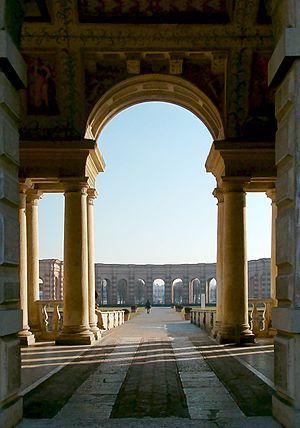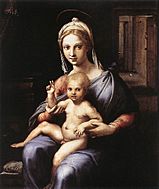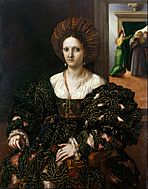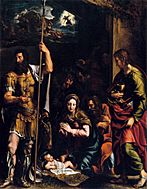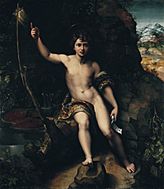Giulio Romano facts for kids
Quick facts for kids
Giulio Romano
|
|
|---|---|
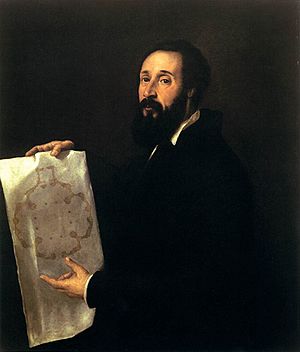
|
|
| Born |
Giulio Pippi
c. 1499 |
| Died | 1 November 1546 (aged 46–47) Mantua, Duchy of Mantua
|
| Nationality | Italian |
| Known for | painting, fresco, architecture |
Giulio Romano (born Giulio Pippi, around 1499 – November 1, 1546) was a talented Italian painter and architect. He was a student of the famous artist Raphael. Giulio's unique style, which was a bit different from the classic art of the High Renaissance, helped create a new art movement called Mannerism. His drawings were very popular, and prints made from them helped spread Italian art across Europe in the 1500s.
Giulio Romano's Life
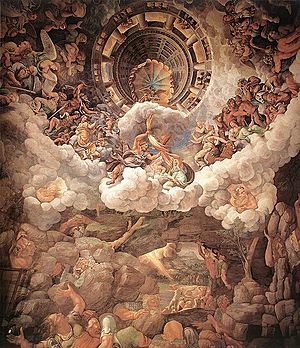
Giulio Pippi was born in Rome. He started his art career as a young helper to the well-known Renaissance artist, Raphael. Giulio was a very important member of Raphael's art studio.
He worked on large wall paintings called frescoes in the Vatican loggias, using Raphael's ideas. In Raphael's Stanze (rooms) in the Vatican, Giulio painted some figures in the Fire in the Borgo fresco. He also helped decorate the ceiling of the Villa Farnesina.
Even though he was young, Giulio became very important to Raphael. After Raphael died in 1520, Giulio helped finish the Vatican frescoes about the life of Constantine. He also helped complete Raphael's Coronation of the Virgin and the Transfiguration in the Vatican. In Rome, Giulio decorated the Villa Madama for Cardinal Giuliano de' Medici, who later became Pope Clement VII. The frescoes he designed were very detailed, but not as calm as his teacher's work.
After Raphael's death, Michelangelo tried to take over the work in the Raphael Rooms at the Vatican. But Giulio, along with Perino del Vaga, was able to keep the job. This was because they had the original drawings for much of the unfinished work.
From 1522, Federico II of Gonzaga, the ruler of Mantua, wanted Giulio to work for him. Federico was especially interested in Giulio's skills as an architect. The historian Giorgio Vasari tells us that Baldassare Castiglione was sent by Gonzaga to get Giulio. He wanted Giulio to create paintings, buildings, and engineering projects for Mantua.
In late 1524, Giulio agreed to move to Mantua. He stayed there for the rest of his life. In Mantua, people called him "Giulio Romano" (Giulio from Rome) to show where he came from. This name became famous because of his amazing work there. The terrible Sack of Rome in 1527 did not affect his work in Mantua. However, this event greatly hurt art projects in Rome and scattered Raphael's former art team.
Giulio's most famous work in Mantua is the Palazzo Te. This country palace has amazing frescoes that create illusions (c. 1525–1535). He also used a special design style for the arches. He helped rebuild the ducal palace in Mantua and redesigned the cathedral. Giulio also created the figure of Christ above Castiglione's tomb in a nearby church. Giulio also helped fix parts of Mantua that often flooded. The duke always supported Giulio, and their friendship lasted. The art school Giulio started in Mantua became very popular.
Giulio traveled to France in the early 1500s. He shared ideas of Italian art with the French court of King Francis I.
Giulio also designed tapestries (woven pictures). It is also believed that he contributed to a collection of drawings for an album called I Modi. These original drawings are said to have been destroyed because their content was not considered acceptable.
Giulio Romano is special because he is the only Renaissance artist mentioned by William Shakespeare. In his play The Winter's Tale, a statue of Queen Hermione comes to life. Shakespeare says this statue was made by "that rare Italian master, Julio Romano."
Giulio died in Mantua in 1546.
Giulio Romano's Architecture
Giulio was very important as an architect. His buildings had a huge impact on Italian Mannerist architecture. He learned architecture the same way he learned painting: by helping Raphael. Raphael became the Pope's architect in 1514, and Giulio's early buildings look a lot like Raphael's style.
When Raphael died, Giulio was given the job of building the Villa Madama outside Rome. This villa was for the future Medici Pope Clement VII. Even in this early work, Giulio showed his love for fun surprises within the style of classical architecture. The villa was planned to be very large, but it was never finished because of the Sack of Rome.
The Villa Lante al Gianicolo (1520–21) was a smaller villa in Rome. It had a famous view over the city. Romano made the building look light and elegant. This helped it fit its hilltop location and overcome its small size. The columns and pilasters (flat columns) were delicate. They were arranged in pairs on the main floor. Above them were very shallow pilasters. Their presence was mostly shown by a different color. Some arch openings were made taller with arches above the main beam. Romano liked to play with the rules of classical design. For example, the Doric style here had small drops but no grooves on its narrow beam. The spirals of the Ionic capitals were repeated around the windows. This showed that the classical styles were becoming more about looks than just structure. This gave the architect new ways to express himself.
His last building in Rome was the Palazzo Maccarani Stati (started 1522–23). This was a big contrast. It was a palace in the city center with shops on the ground floor. It felt very strong and imposing. The rough stone work and very large keystones (top stones of an arch) that would be famous in his later Mantuan buildings were already on the ground floor. This floor did not use any classical style. But the two upper floors had increasingly shallow pilasters, similar to the Villa Lante.
His first building in Mantua is still his most famous architectural work. The Palazzo del Te was a pleasure palace outside the city. It was started around 1524 and finished ten years later. Here, Giulio could fully use his playful and creative ideas because of what the building was used for.
Selected Paintings and Drawings
- Deesis with Saint Paul and Saint Catherine - Parma
- The Stoning of St. Stephen (Santo Stefano, Genoa): "Giulio never did a finer work than this," said Giorgio Vasari.
- Adoration of the Magi (Louvre)
- Fire in the Borgo, fresco (Raphael Rooms in Vatican City)
- Emblematic Figures, pen and brown ink and wash over graphite (Fine Arts Museum of San Francisco)
- Portrait of a Young Woman, after a design by Raphael (Musée des Beaux-Arts de Strasbourg)
- The Battle of the Milvian Bridge
- The Triumph of Titus and Vespasian
- Portrait of Doña Isabel de Requesens y Enriquez de Cardona-Anglesola
- Madonna of the Cat (National Museum of Capodimonte, Naples, 1522–23)
- Noli me tangere, Prado Museum, Madrid
- Adoration of the Shepherds in collaboration with Giovanni Francesco Penni, Prado Museum, Madrid
- Gallery of paintings by Giulio Romano
See also
 In Spanish: Giulio Romano para niños
In Spanish: Giulio Romano para niños


